Digestion Quizzes Anatomy and Physiology
Children are fascinated by the workings of the digestive organisation: they relish crunching a potato chip, delight in making "mustaches" with milk, and giggle when their stomach growls. Equally adults, we know that a healthy digestive system is essential for expert health because it converts nutrient into raw materials that build and fuel our body cells.
Functions of the Digestive System
The functions of the digestive arrangement are:
- Ingestion. Food must be placed into the mouth before it can exist acted on; this is an agile, voluntary process called ingestion.
- Propulsion. If foods are to be processed past more one digestive organ, they must be propelled from 1 organ to the adjacent; swallowing is one case of food movement that depends largely on the propulsive procedure called peristalsis (involuntary, alternating waves of contraction and relaxation of the muscles in the organ wall).
- Food breakdown: mechanical digestion. Mechanical digestion prepares food for further degradation past enzymes past physically fragmenting the foods into smaller pieces, and examples of mechanical digestion are: mixing of nutrient in the oral cavity by the natural language, churning of food in the tum, and segmentation in the minor intestine.
- Food breakdown: chemical digestion. The sequence of steps in which the big food molecules are broken down into their building blocks past enzymes is called chemic digestion.
- Absorption. Transport of digested end products from the lumen of the GI tract to the claret or lymph is absorption, and for assimilation to happen, the digested foods must first enter the mucosal cells past active or passive transport processes.
- Defecation. Defecation is the elimination of indigestible residues from the GI tract via the anus in the form of feces.
Anatomy of the Digestive Organization
The organs of the digestive system can be separated into two principal groups: those forming the alimentary canal and the accessory digestive organs.
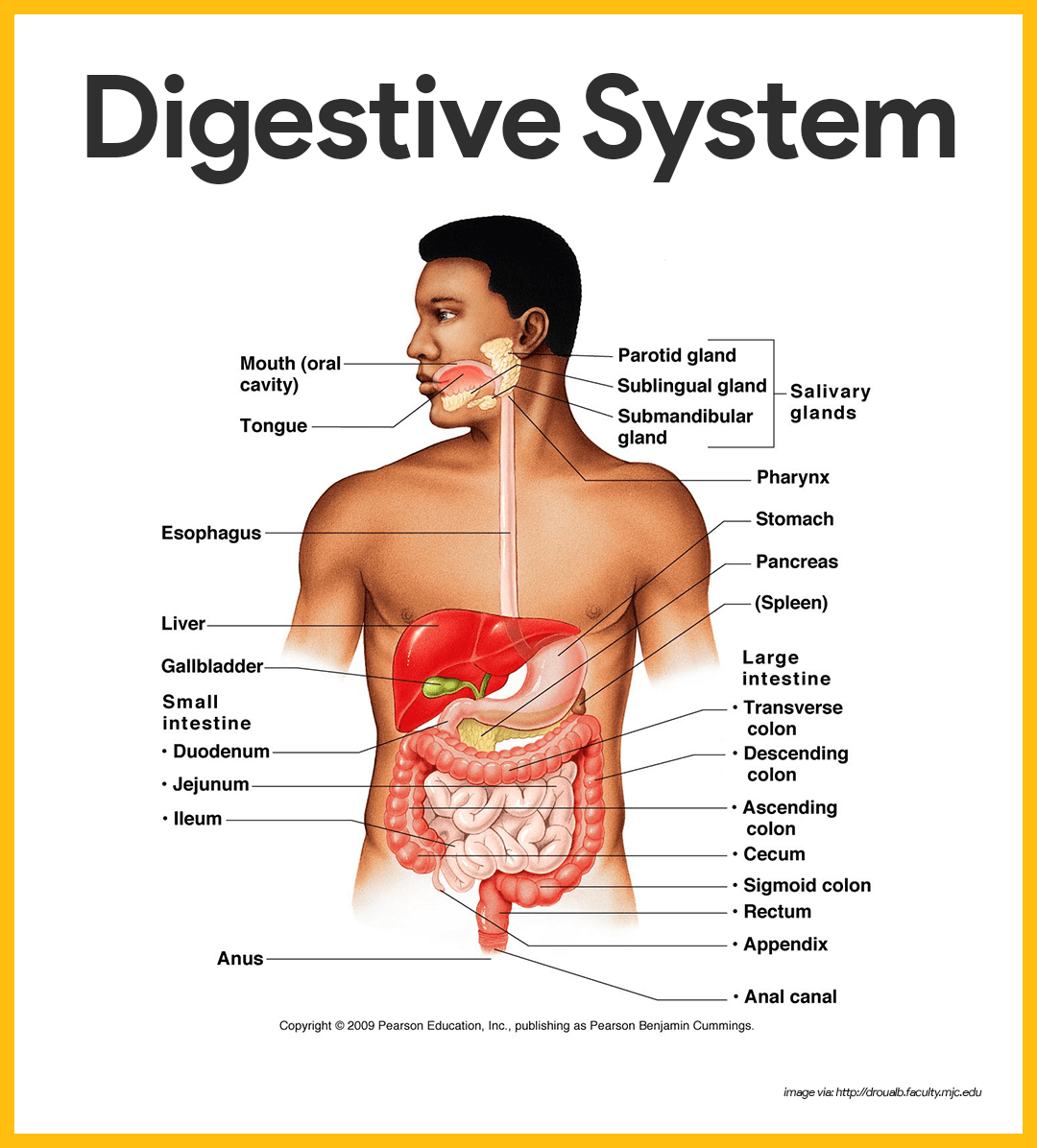
Organs of the Gastrointestinal tract
The gastrointestinal tract, also called the alimentary canal, is a continuous, hollow muscular tube that winds through the ventral body crenel and is open at both ends. Its organs include the post-obit:
Mouth
Food enters the digestive tract through the mouth, or oral fissure, a mucous membrane-lined cavity.
- Lips. The lips (labia) protect its anterior opening.
- Cheeks. The cheeks form its lateral walls.
- Palate. The difficult palate forms its anterior roof, and the soft palate forms its posterior roof.
- Uvula. The uvula is a fleshy finger-like projection of the soft palate, which extends inferiorly from the posterior edge of the soft palate.
- Vestibule. The space between the lips and the cheeks externally and the teeth and gums internally is the vestibule.
- Oral cavity proper. The area independent by the teeth is the oral cavity proper.
- Tongue. The muscular tongue occupies the floor of the mouth and has several bony attachments- two of these are to the hyoid bone and the styloid processes of the skull.
- Lingual frenulum. The lingual frenulum, a fold of mucous membrane, secures the natural language to the flooring of the mouth and limits its posterior movements.
- Palatine tonsils. At the posterior stop of the oral cavity are paired masses of lymphatic tissue, the palatine tonsils.
- Lingual tonsil. The lingual tonsils cover the base of operations of the tongue just across.
Pharynx
From the rima oris, food passes posteriorly into the oropharynx and laryngopharynx.
- Oropharynx. The oropharynx is posterior to the mouth.
- Laryngopharynx. The laryngopharynx is continuous with the esophagus beneath; both of which are common passageways for food, fluids, and air.
Esophagus
The esophagus or gullet, runs from the pharynx through the diaphragm to the tum.
- Size and part. Near 25 cm (10 inches) long, it is essentially a passageway that conducts food past peristalsis to the stomach.
- Structure. The walls of the alimentary canal organs from the esophagus to the large intestine are made up of the same four bones tissue layers or tunics.
- Mucosa. The mucosa is the innermost layer, a moist membrane that lines the cavity, or lumen, of the organ; information technology consists primarily of a surface epithelium, plus a small amount of connective tissue (lamina propria) and a scanty smooth musculus layer.
- Submucosa. The submucosa is found just beneath the mucosa; it is a soft connective tissue layer containing claret vessels, nerve endings, lymph nodules, and lymphatic vessels.
- Muscularis externa. The muscularis externa is a muscle layer typically made up of an inner circular layer and an outer longitudinal layer of smoothen musculus cells.
- Serosa. The serosa is the outermost layer of the wall that consists of a unmarried layer of apartment serous fluid-producing cells, the visceral peritoneum.
- Intrinsic nerve plexuses. The alimentary canal wall contains ii important intrinsic nerve plexuses- the submucosal nervus plexus and the myenteric nerve plexus, both of which are networks of nervus fibers that are really office of the autonomic nervous system and help regulate the mobility and secretory activity of the GI tract organs.
Stomach
Dissimilar regions of the stomach accept been named, and they include the following:
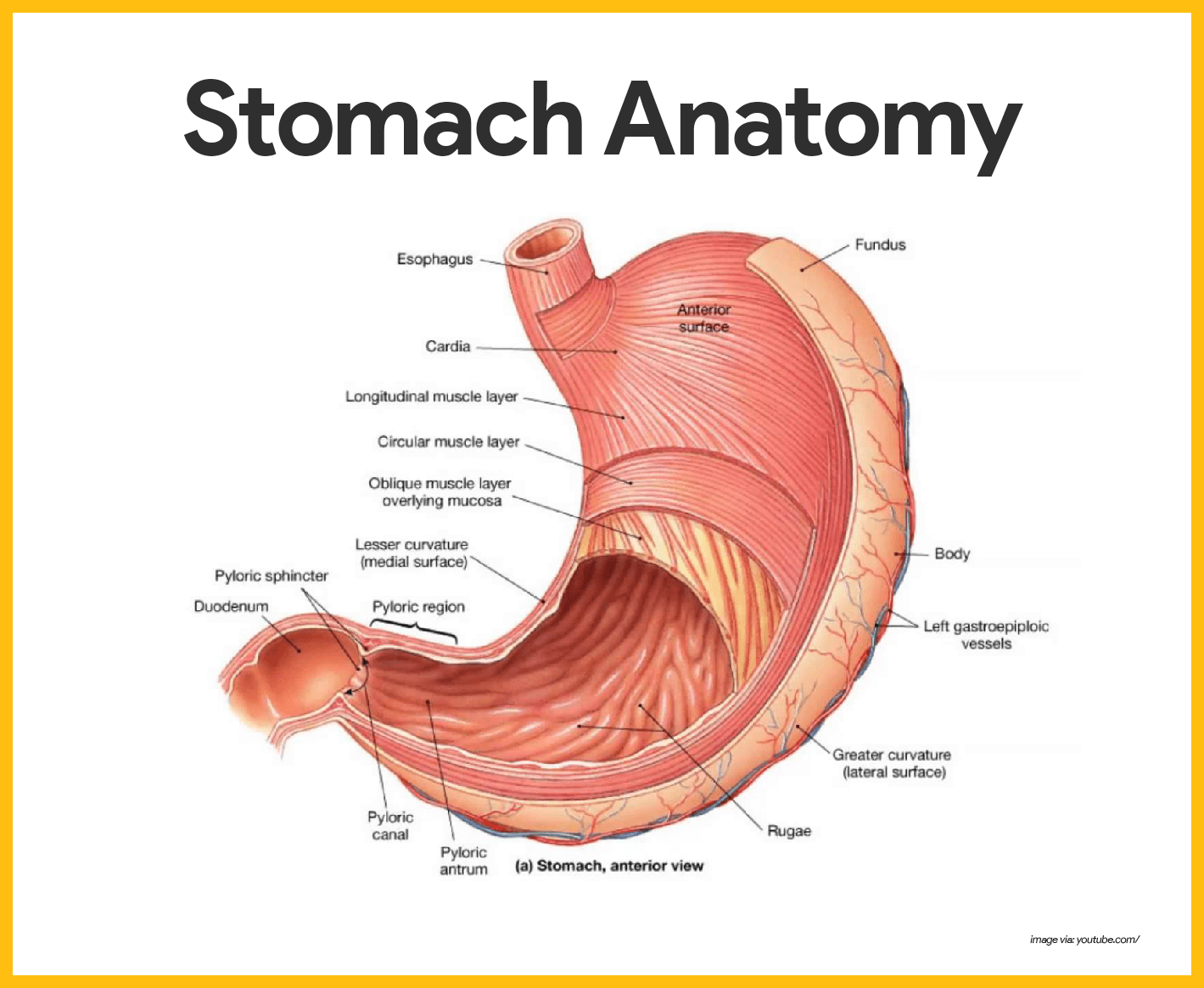
- Location. The C-shaped stomach is on the left side of the abdominal crenel, nearly subconscious past the liver and the diaphragm.
- Office. The stomach acts equally a temporary "storage tank" for food as well as a site for food breakdown.
- Cardiac region. The cardiac region surrounds the cardioesophageal sphincter, through which food enters the tum from the esophagus.
- Fundus. The fundus is the expanded part of the stomach lateral to the cardiac region.
- Torso. The body is the midportion, and as it narrows inferiorly, it becomes the pyloric antrum, so the funnel-shaped pylorus.
- Pylorus. The pylorus is the last office of the stomach and it is continuous with the pocket-sized intestine through the pyloric sphincter or valve.
- Size. The tummy varies from xv to 25 cm in length, just its bore and book depend on how much nutrient it contains; when information technology is full, information technology tin hold about 4 liters (1 gallon) of food, only when it is empty it collapses inward on itself.
- Rugae. The mucosa of the stomach is thrown into large folds called rugae when it is empty.
- Greater curvature. The convex lateral surface of the breadbasket is the greater curvature.
- Lesser curvature. The concave medial surface is the lesser curvature.
- Lesser omentum. The lesser omentum, a double layer of peritoneum, extends from the liver to the greater curvature.
- Greater omentum. The greater omentum, another extension of the peritoneum, drapes downward and covers the abdominal organs like a lacy frock before attaching to the posterior body wall, and is riddled with fat, which helps to insulate, cushion, and protect the intestinal organs.
- Stomach mucosa. The mucosa of the stomach is a simple columnar epithelium equanimous entirely of mucous cells that produce a protective layer of bicarbonate-rich alkaline mucus that clings to the stomach mucosa and protects the stomach wall from being damaged past acid and digested past enzymes.
- Gastric glands. This otherwise polish lining is dotted with millions of deep gastric pits, which lead into gastric glands that secrete the solution called gastric juice.
- Intrinsic gene. Some tum cells produce intrinsic factor, a substance needed for the absorption of vitamin b12 from the modest intestine.
- Chief cells. The chief cells produce protein-digesting enzymes, generally pepsinogens.
- Parietal cells. The parietal cells produce corrosive hydrochloric acid, which makes the stomach contents acidic and activates the enzymes.
- Enteroendocrine cells. The enteroendocrine cells produce local hormones such every bit gastrin, that are of import to the digestive activities of the tummy.
- Chyme. After nutrient has been processed, it resembles heavy cream and is called chyme.
Pocket-size Intestine
The small-scale intestine is the body's major digestive organ.
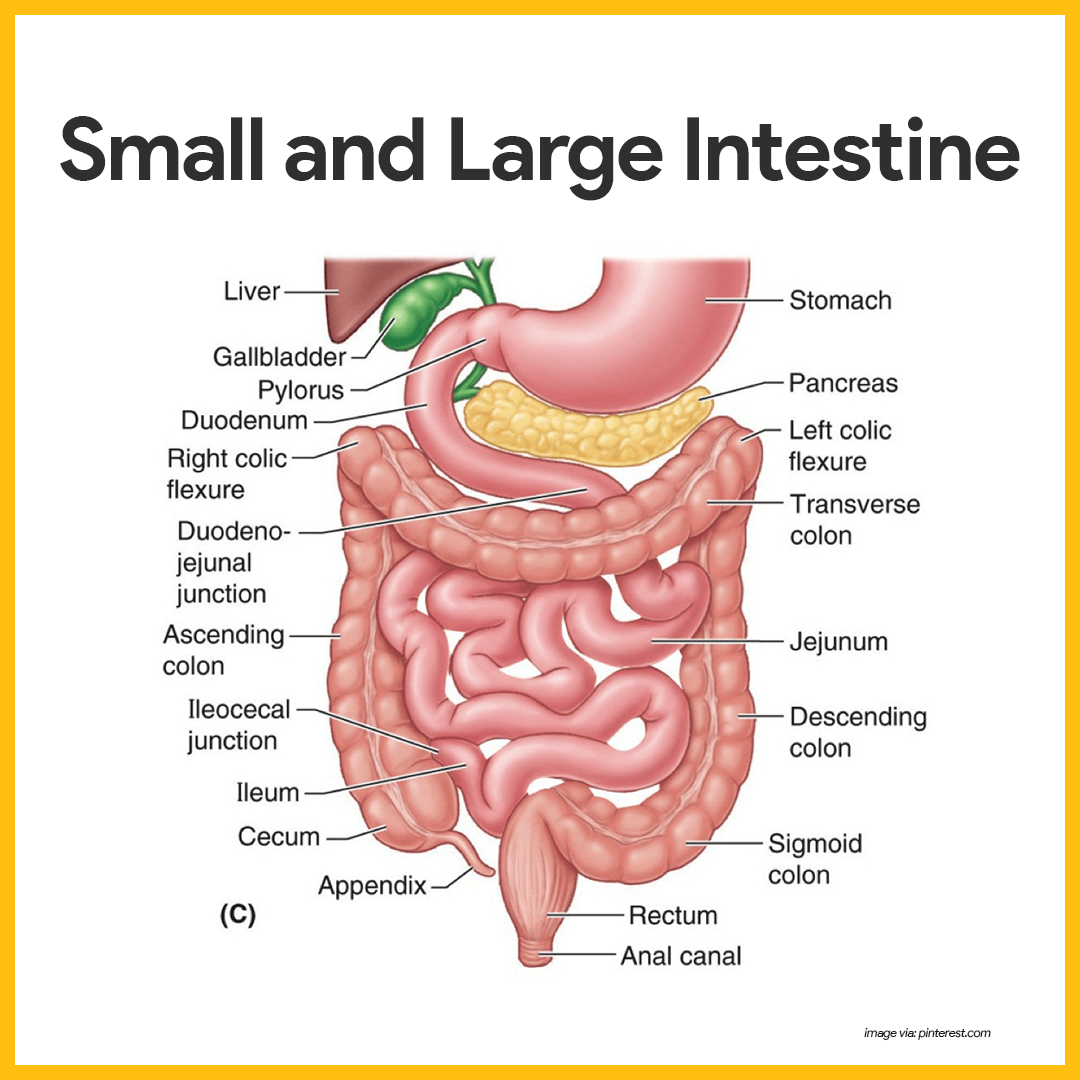
- Location. The small intestine is a muscular tube extending from the pyloric sphincter to the large intestine.
- Size. It is the longest section of the comestible tube, with an boilerplate length of 2.five to 7 one thousand (8 to 20 feet) in a living person.
- Subdivisions. The pocket-sized intestine has three subdivisions: the duodenum, the jejunum, and the ileum, which contribute 5 percent, nearly 40 pct, and nearly 60 percent of the small intestine, respectively.
- Ileocecal valve. The ileum meets the large intestine at the ileocecal valve, which joins the large and small intestine.
- Hepatopancreatic ampulla. The principal pancreatic and bile ducts bring together at the duodenum to course the flasklike hepatopancreatic ampulla, literally, the " liver-pacreatic-enlargement".
- Duodenal papilla. From at that place, the bile and pancreatic juice travel through the duodenal papilla and enter the duodenum together.
- Microvilli. Microvilli are tiny projections of the plasma membrane of the mucosa cells that give the cell surface a fuzzy appearance, sometimes referred to as the brush border; the plasma membranes bear enzymes (brush edge enzymes) that complete the digestion of proteins and carbohydrates in the small intestine.
- Villi. Villi are fingerlike projections of the mucosa that give information technology a velvety advent and experience, much like the soft nap of a towel.
- Lacteal. Within each villus is a rich capillary bed and a modified lymphatic capillary called a lacteal.
- Circular folds. Circular folds, besides called plicae circulares, are deep folds of both mucosa and submucosa layers, and they do not disappear when nutrient fills the small-scale intestine.
- Peyer's patches. In contrast, local collections of lymphatic tissue found in the submucosa increment in number toward the end of the small intestine.
Large Intestine
The large intestine is much larger in diameter than the pocket-size intestine simply shorter in length.
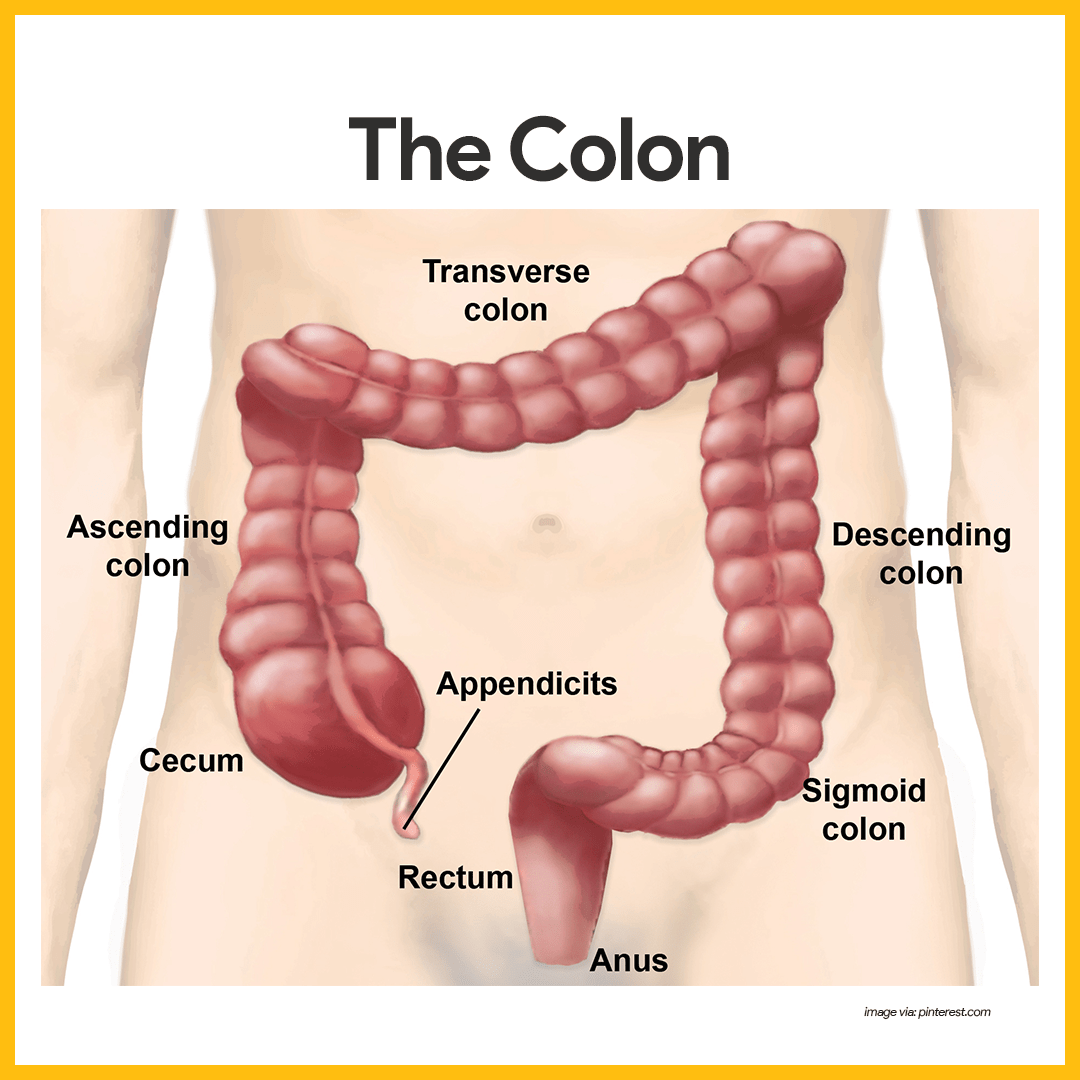
- Size. About one.5 one thousand (five feet) long, information technology extends from the ileocecal valve to the anus.
- Functions. Its major functions are to dry out out boxy food residuum by arresting water and to eliminate these residues from the torso every bit feces.
- Subdivisions. It frames the small intestines on 3 sides and has the post-obit subdivisions: cecum, appendix, colon, rectum, and anal canal.
- Cecum. The saclike cecum is the showtime part of the large intestine.
- Appendix. Hanging from the cecum is the wormlike appendix, a potential trouble spot because it is an ideal location for leaner to accumulate and multiply.
- Ascending colon. The ascending colon travels up the right side of the intestinal crenel and makes a turn, the right colic (or hepatic) flexure, to travel across the abdominal cavity.
- Transverse colon. The ascending colon makes a plough and continuous to be the transverse colon equally it travels across the abdominal cavity.
- Descending colon. It and then turns again at the left colic (or splenic) flexure, and continues down the left side every bit the descending colon.
- Sigmoid colon. The intestine and then enters the pelvis, where it becomes the South-shaped sigmoid colon.
- Anal canal. The anal canal ends at the anus which opens to the exterior.
- External anal sphincter. The anal canal has an external voluntary sphincter, the external anal sphincter, composed of skeletal muscle.
- Internal involuntary sphincter. The internal involuntary sphincter is formed by smooth muscles.
Accompaniment Digestive Organs
Other than the intestines and the breadbasket, the following are besides part of the digestive system:
Teeth
The function the teeth play in food processing needs piffling introduction; we masticate, or chew, by opening and endmost our jaws and moving them from side to side while continuously using our tongue to move the food between our teeth.
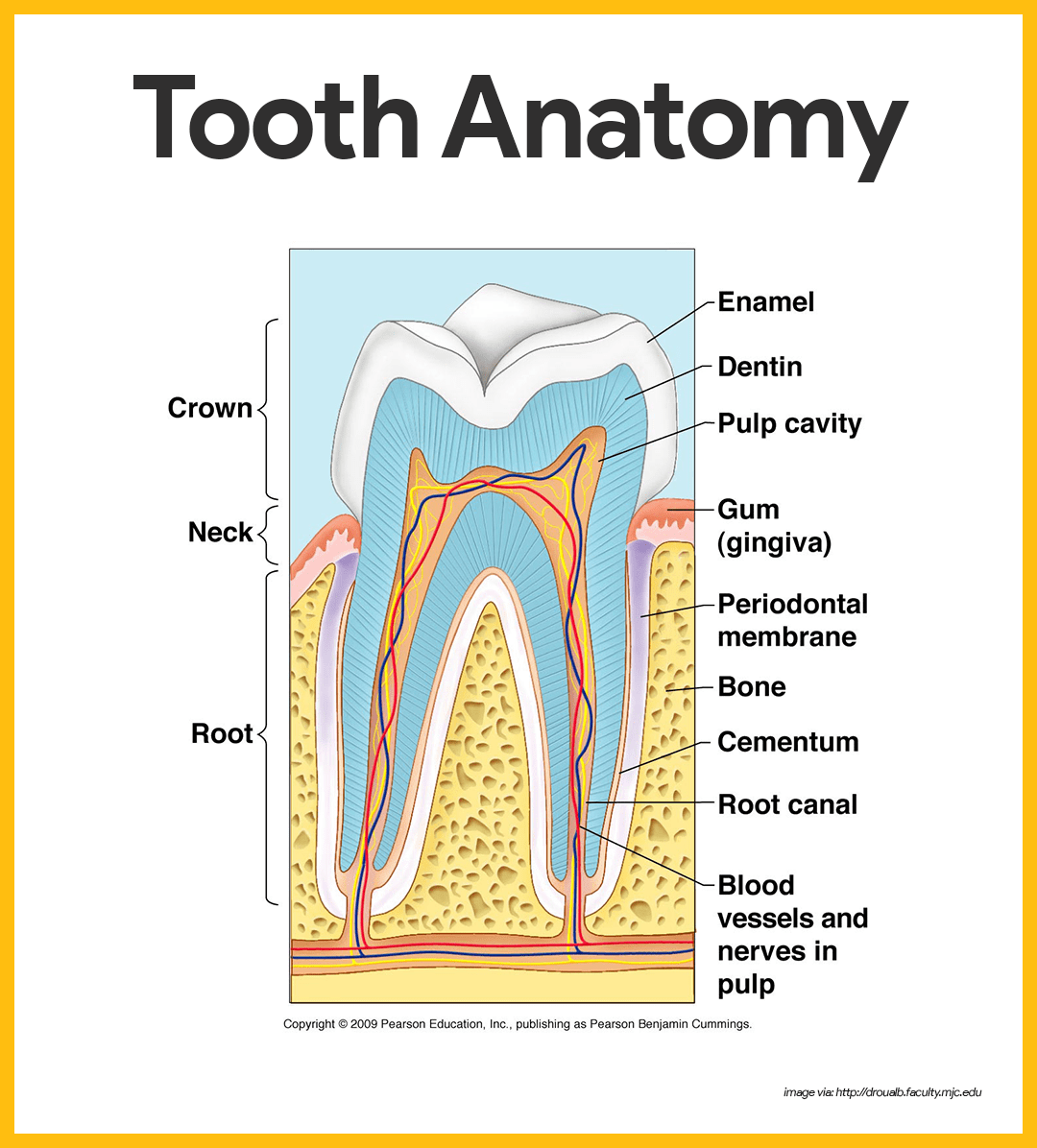
- Function. The teeth tear and grind the food, breaking it down into smaller fragments.
- Deciduous teeth. The showtime set of teeth is the deciduous teeth, likewise called baby teeth or milk teeth, and they begin to erupt around 6 months, and a babe has a full set (20 teeth) by the age of 2 years.
- Permanent teeth. As the 2d prepare of teeth, the deeper permanent teeth, enlarge and develop, the roots of the milk teeth are reabsorbed, and between the ages of 6 to 12 years they loosen and fall out.
- Incisors. The chisel-shaped incisors are adapted for cutting.
- Canines. The fanglike canines are for tearing and piercing.
- Premolars and molars. Premolars (bicuspids) and molars have broad crowns with round cusps ( tips) and are all-time suited for grinding.
- Crown. The enamel-covered crown is the exposed part of the tooth above the gingiva or mucilage.
- Enamel. Enamel is the hardest substance in the body and is fairly brittle because it is heavily mineralized with calcium salts.
- Root. The outer surface of the root is covered past a substance called cementum, which attaches the tooth to the periodontal membrane (ligament).
- Dentin. Dentin, a bonelike cloth, underlies the enamel and forms the bulk of the tooth.
- Pulp cavity. It surrounds a central pulp cavity, which contains a number of structures (connective tissue, blood vessels, and nerve fibers) collectively chosen the pulp.
- Root canal. Where the pulp cavity extends into the root, it becomes the root canal, which provides a road for blood vessels, fretfulness, and other pulp structures to enter the lurid cavity of the tooth.
Salivary Glands
3 pairs of salivary glands empty their secretions into the mouth.
- Parotid glands. The large parotid glands lie anterior to the ears and empty their secretions into the rima oris.
- Submandibular and sublingual glands. The submandibular and sublingual glands empty their secretions into the flooring of the mouth through tiny ducts.
- Saliva. The product of the salivary glands, saliva, is a mixture of mucus and serous fluids.
- Salivary amylase. The articulate serous portion contains an enzyme, salivary amylase, in a bicarbonate-rich juice that begins the process of starch digestion in the mouth.
Pancreas
Simply the pancreas produces enzymes that pause downwards all categories of digestible foods.
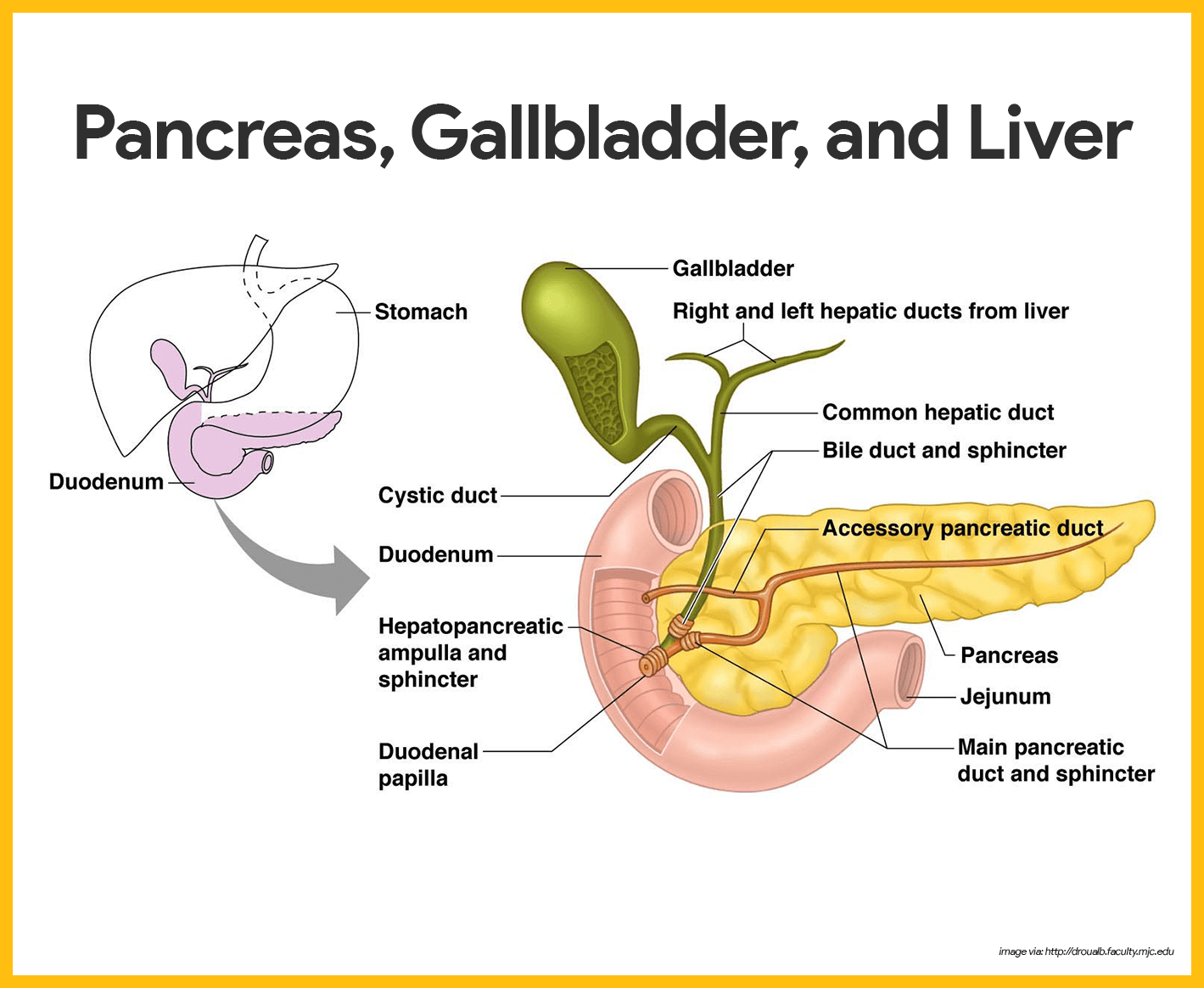
- Location. The pancreas is a soft, pink triangular gland that extends across the abdomen from the spleen to the duodenum; merely most of the pancreas lies posterior to the parietal peritoneum, hence its location is referred to as retroperitoneal.
- Pancreatic enzymes. The pancreatic enzymes are secreted into the duodenum in an alkaline metal fluid that neutralizes the acidic chyme coming in from the stomach.
- Endocrine function. The pancreas also has an endocrine function; it produces hormones insulin and glucagon.
Liver
The liver is the largest gland in the body.
- Location. Located under the diaphragm, more to the right side of the trunk, information technology overlies and almost completely covers the breadbasket.
- Falciform ligament. The liver has four lobes and is suspended from the diaphragm and abdominal wall by a delicate mesentery cord, the falciform ligament.
- Part. The liver's digestive function is to produce bile.
- Bile. Bile is a xanthous-to-green, watery solution containing bile salts, bile pigments, cholesterol, phospholipids, and a variety of electrolytes.
- Bile salts. Bile does not contain enzymes merely its bile salts emulsify fats past physically breaking large fat globules into smaller ones, thus providing more surface surface area for the fat-digesting enzymes to work on.
Gallbladder
While in the gallbladder, bile is concentrated by the removal of water.
- Location. The gallbladder is a small-scale, thin-walled green sac that snuggles in a shallow fossa in the junior surface of the liver.
- Cystic duct. When food digestion is non occurring, bile backs upwards the cystic duct and enters the gallbladder to be stored.
Physiology of the Digestive Organization
Specifically, the digestive arrangement takes in food (ingests it), breaks it down physically and chemically into nutrient molecules (digests it), and absorbs the nutrients into the bloodstream, and so, it rids the body of boxy remains (defecates).
Activities Occurring in the Mouth, Throat, and Esophagus
The activities that occur in the mouth, pharynx, and esophagus are food ingestion, food breakdown, and food propulsion.
Food Ingestion and Breakdown
Once nutrient is placed in the mouth, both mechanical and chemical digestion brainstorm.
- Physical breakdown. Beginning, the food is physically cleaved down into smaller particles by chewing.
- Chemical breakdown. Then, as the food is mixed with saliva, salivary amylase begins the chemical digestion of starch, breaking it downwards into maltose.
- Stimulation of saliva. When food enters the oral fissure, much larger amounts of saliva pour out; all the same, the simple pressure level of anything put into the mouth and chewed will as well stimulate the release of saliva.
- Passageways. The pharynx and the esophagus have no digestive function; they simply provide passageways to carry food to the side by side processing site, the tum.
Food Propulsion – Swallowing and Peristalsis
For food to be sent on its mode to the oral fissure, it must starting time exist swallowed.
- Deglutition. Deglutition, or swallowing, is a complex process that involves the coordinated activity of several structures (tongue, soft palate, pharynx, and esophagus).
- Buccal phase of deglutition. The first phase, the voluntary buccal phase, occurs in the mouth; once the food has been chewed and well mixed with saliva, the bolus (food mass) is forced into the pharynx by the tongue.
- Pharyngeal-esophageal phase. The 2d phase, the involuntary pharyngeal-esophageal stage, transports food through the pharynx and esophagus; the parasympathetic segmentation of the autonomic nervous arrangement controls this phase and promotes the mobility of the digestive organs from this signal on.
- Food routes. All routes that the food may accept, except the desired route distal into the digestive tract, are blocked off; the natural language blocks off the oral fissure; the soft palate closes off the nasal passages; the larynx rises and so that its opening is covered by the flaplike epiglottis.
- Tummy archway. Once food reaches the distal end of the esophagus, it presses against the cardioesophageal sphincter, causing it to open, and food enters the stomach.
Activities of the Stomach
The activities of the stomach involve food breakdown and food propulsion.
Food Breakdown
The sight, odour, and taste of nutrient stimulate parasympathetic nervous system reflexes, which increase the secretion of gastric juice past the tummy glands
- Gastric juice. Secretion of gastric juice is regulated by both neural and hormonal factors.
- Gastrin. The presence of food and a rising pH in the tummy stimulate the tum cells to release the hormone gastrin, which prods the stomach glands to produce nonetheless more of the protein-digesting enzymes (pepsinogen), mucus, and hydrochloric acid.
- Pepsinogen. The extremely acidic environment that muriatic acid provides is necessary, because it activates pepsinogen to pepsin, the active protein-digesting enzyme.
- Rennin. Rennin, the second protein-digesting enzyme produced past the stomach, works primarily on milk protein and converts it to a substance that looks like sour milk.
- Food entry. Every bit nutrient enters and fills the stomach, its wall begins to stretch (at the aforementioned time as the gastric juices are being secreted).
- Tummy wall activation. Then the three musculus layers of the stomach wall become active; they shrink and pummel the food, breaking information technology apart physically, all the while continuously mixing the food with the enzyme-containing gastric juice and so that the semifluid chyme is formed.
Food Propulsion
Peristalsis is responsible for the movement of food towards the digestive site until the intestines.
- Peristalsis. Once the food has been well mixed, a rippling peristalsis begins in the upper half of the stomach, and the contractions increase in force as the food approaches the pyloric valve.
- Pyloric passage. The pylorus of the breadbasket, which holds about 30 ml of chyme, acts similar a meter that allows only liquids and very small particles to pass through the pyloric sphincter; and considering the pyloric sphincter barely opens, each contraction of the breadbasket muscle squirts iii ml or less of chyme into the small intestine.
- Enterogastric reflex. When the duodenum is filled with chyme and its wall is stretched, a nervous reflex, the enterogastric reflex, occurs; this reflex "puts the brakes on" gastric activity and slows the emptying of the tummy by inhibiting the vagus nerves and tightening the pyloric sphincter, thus allowing time for intestinal processing to catch up.
Activities of the Small Intestine
The activities of the small intestine are food breakdown and absorption and food propulsion.
Food Breakup and Absorption
Food reaching the small intestine is merely partially digested.
- Digestion. Nutrient reaching the small intestine is just partially digested; carbohydrate and protein digestion has begun, but almost no fats have been digested upward to this indicate.
- Brush border enzymes. The microvilli of small intestine cells bears a few important enzymes, the so-called brush border enzymes, that intermission downwards double sugars into simple sugars and complete protein digestion.
- Pancreatic juice. Foods entering the pocket-sized intestine are literally deluged with enzyme-rich pancreatic juice ducted in from the pancreas, too equally bile from the liver; pancreatic juice contains enzymes that, forth with brush border enzymes, complete the digestion of starch, carry out about half of the protein digestion, and are totally responsible for fat digestion and digestion of nucleic acids.
- Chyme stimulation. When chyme enters the minor intestine, it stimulates the mucosa cells to produce several hormones; two of these are secretin and cholecystokinin which influence the release of pancreatic juice and bile.
- Absorption. Absorption of water and of the end products of digestion occurs all along the length of the small intestine; well-nigh substances are absorbed through the abdominal cell plasma membranes by the procedure of active transport.
- Diffusion. Lipids or fats are absorbed passively past the procedure of improvidence.
- Debris. At the end of the ileum, all that remains are some water, indigestible food materials, and big amounts of bacteria; this droppings enters the large intestine through the ileocecal valve.
Nutrient Propulsion
Peristalsis is the major means of propelling food through the digestive tract.
- Peristalsis. The internet effect is that the food is moved through the pocket-sized intestine in much the aforementioned style that toothpaste is squeezed from the tube.
- Constrictions. Rhythmic segmental movements produce local constrictions of the intestine that mix the chyme with the digestive juices, and help to propel food through the intestine.
Activities of the Large Intestine
The activities of the large intestine are food breakup and assimilation and defecation.
Food Breakdown and Absorption
What is finally delivered to the large intestine contains few nutrients, but that residue still has 12 to 24 hours more to spend at that place.
- Metabolism. The "resident" bacteria that live in its lumen metabolize some of the remaining nutrients, releasing gases (methyl hydride and hydrogen sulfide) that contribute to the odor of feces.
- Flatus. About 50 ml of gas (flatus) is produced each day, much more than when sure carbohydrate-rich foods are eaten.
- Absorption. Assimilation by the large intestine is express to the absorption of vitamin K, some B vitamins, some ions, and near of the remaining water.
- Carrion. Feces, the more or less solid product delivered to the rectum, contains undigested food residues, mucus, millions of bacteria, and only enough h2o to allow their smooth passage.
Propulsion of the Rest and Defecation
When presented with residue, the colon becomes mobile, but its contractions are sluggish or short-lived.
- Haustral contractions. The movements almost seen in the colon are haustral contractions, tiresome segmenting movements lasting most one infinitesimal that occur every 30 minutes or and then.
- Propulsion. As the haustrum fills with food residue, the distension stimulates its muscle to contract, which propels the luminal contents into the adjacent haustrum.
- Mass movements. Mass movements are long, tedious-moving, simply powerful contractile waves that move over large areas of the colon three or four times daily and force the contents toward the rectum.
- Rectum. The rectum is by and large empty, merely when feces are forced into it past mass movements and its wall is stretched, the defecation reflex is initiated.
- Defecation reflex. The defecation reflex is a spinal (sacral region) reflex that causes the walls of the sigmoid colon and the rectum to contract and anal sphincters to relax.
- Impulses. As the feces is forced into the anal culvert, letters reach the brain giving us time to make a decision as to whether the external voluntary sphincter should remain open or be constricted to end passage of feces.
- Relaxation. Within a few seconds, the reflex contractions end and rectal walls relax; with the next mass movement, the defecation reflex is initiated again.
Practice Quiz: Digestive Organisation Anatomy and Physiology
Here'due south a ten-item quiz about the study guide. Please visit our nursing test bank folio for more NCLEX do questions.
1. All of these are among the 4 tunics found throughout the digestive tract EXCEPT:
A. Mucosa
B. Glandulosa
C. Submucosa
D. Muscularis
1. Answer: B. Glandulosa
- B:The quaternary, or outermost, layer of the digestive tract is either a serosa or an adventitia .
- A: The innermost tunic, the mucosa , consists of mucous epithelium, a loose connective tissue called the lamina propria, and a thin smooth muscle layer, the muscularis mucosa.
- C: The submucosa lies just exterior the mucosa. Information technology is a thick layer of loose connective tissue containing nerves, blood vessels, and small glands. An all-encompassing network of nervus cell processes from a plexus.
- D: The adjacent tunic is the muscularis , which in almost parts of the digestive tube consists of an inner layer of circular smooth musculus and an outer layer of longitudinal polish muscle.
2. Which of the following are functions of the natural language? Select all that utilise.
A. Crucial organ for speech
B. Primary organ for taste
C. Vital for swallowing food
D. Manipulates food for mastication
E. All of these are functions of the tongue
2. Answer: E. All of these are functions of the natural language
- E: The tongue is a large, muscular organ that occupies almost of the oral cavity. It moves food in the mouth and, in cooperation with the lips and cheeks, holds the food in place during mastication. Information technology too plays a major office in the process of swallowing. The tongue is a major sensory organ for taste, every bit well every bit existence one of the major organs of speech.
iii. Each quadrant of the adult oral cavity holds ___ incisors, ___ canines, ___ premolars, and ___ molars.
A. 1, 2, 3, 2
B. 1, 2, 2, 3
C. 2, 1, 3, two
D. 2, 1, 2, 3
3. Reply: D. ii, i, 2, 3
- D: There are 32 teeth in the normal developed mouth, located in the mandible and maxillae. The teeth can be divided into quadrants: right upper, left upper, right lower, and left lower. In adults, each quadrant contains ane key and ane lateral incisor; one canine; first and 2d premolars; and first, second, and third molars.
4. Which of these is Non a pair of salivary glands?
A. Parotid
B. Submandibular
C. Submucosal
D. Sublingual
4. Answer: C. Submucosal
- A:The largest of the salivary glands, the parotid glands , are serous glands located just anterior to each ear. Parotid ducts enter the oral cavity adjacent to the second upper molars.
- B: The submandibular glands produce more serous than mucous secretions. Each gland can be felt as a soft lump along the inferior border of the mandible. The submandibular ducts open into the oral crenel on each side of the frenulum of the tongue.
- D: The sublingual glands, the smallest of the 3 paired salivary glands, produce primarily mucous secretions. They lie immediately beneath the mucous membrane in the flooring of the oral fissure.
5. Which argument about the esophagus is TRUE? Select all that apply.
A. It is a cartilaginous tube.
B. Information technology extends from the nasal cavity to the stomach.
C. It lies anterior to the trachea.
D. It has upper and lower sphincters.
E. All statements depict the esophagus.
v. Reply: D. It has upper and lower sphincters.
- D: Upper and lower esophageal sphincters, located at the upper and lower ends of the esophagus, respectively, regulate the movement of food into and out of the esophagus.
- A: The esophagus is a muscular tube, lined with moist stratified squamous epithelium.
- B: Information technology extends from the pharynx to the stomach. It is about 25 centimeters (cm) long.
- C: It lies anterior to the vertebrae and posterior to the trachea inside the mediastinum.
6. All of these structures are matched with the right description EXCEPT:
A. Cardiac region: the expanse closest to the small intestine
B. Fundus: the virtually superior portion of the stomach
C. Pyloric opening: opening from the tum into the small intestine
D. Torso: the largest portion of the stomach
vi. Answer: A. Cardiac region: the area closest to the small intestine
- A: The opening from the esophagus into the stomach is called the cardiac opening because it is nigh the heart. The region of the stomach around the cardiac opening is chosen the cardiac region .
- B: The nigh superior part of the tum is the fundus .
- C :The opening from the stomach into the small intestine is the pyloric opening , which is surrounded by a relatively thick ring of smoothen muscle called the pyloric sphincter . The region of the stomach nigh the pyloric opening is the pyloric region .
- D: The largest role of the stomach is the body , which turns to the correct, forming a greater curvature on the left, and a lesser curvature on the right.
7. The saliva does NOT contain:
A. Amylase
B. Lysozyme
C. Mucin
D. Hydrochloric acid
7. Answer: D. Muriatic acid
- D: Saliva does not contain hydrochloric acid.
- A: The serous part of saliva, produced mainly past the parotid and submandibular glands, contains a digestive enzyme chosen salivary amylase .
- B: Saliva prevents bacterial infection in the mouth by washing the oral cavity, and information technology contains lysozyme , which has a weak antibacterial activeness.
- C: The serous part of saliva dissolves molecules, which must be in solution to stimulate taste receptors. The mucous secretions of the submandibular and sublingual glands comprise a big amount of mucin , a proteoglycan that gives a lubricating quality tot he secretions of the salivary glands.
8. Which statements best depict mechanical digestion? Select all that apply.
A. It breaks large food particles into smaller ones.
B. It involves the breaking of covalent chemical bonds in organic molecules past digestive enzymes.
C. It begins in the tummy, where some pocket-size, lipid-soluble molecules, such equally alcohol and aspirin, can diffuse through the stomach epithelium into the circulation.
D. It requires carrier molecules and includes facilitated improvidence, cotransport, and agile transport.
East. All the statements draw mechanical digestion.
viii. Answer: A. It breaks large food particles into smaller ones.
- A: Mechanical digestion breaks large food particles down into smaller ones.
- B: Chemical digestion involves the breaking of covalent chemical bonds in organic molecules by digestive enzymes.
- C: Absorption begins in the stomach, where some small, lipid-soluble molecules, such as alcohol and aspirin, tin can diffuse through the breadbasket epithelium into the circulation.
- D: Transport requires carrier molecules and includes facilitated diffusion, cotransport, and active transport.
9. The greatest volume of gastric secretion occurs during:
A. Cephalic phase
B. Gastric phase
C. Abdominal stage
D. Deglutition
nine. Answer: B. Gastric phase
- B: The gastric phase is the catamenia of greatest gastric secretion. This phase is responsible for the greatest book of gastric secretions, and it is activated by the presence of food in the stomach.
- A: The cephalic phase of tummy secretion is anticipatory and prepares the stomach to receive nutrient. In the cephalic phase, sensations of sense of taste, the olfactory property of food, stimulation of tactile receptors during the procedure of chewing and swallowing, and pleasant thoughts of food stimulate centers within the medulla oblongata that influence gastric secretions.
- C: The abdominal stage of gastric secretion primarily inhibits gastric secretions. It is controlled by the entrance of acidic chyme into the duodenum. The presence of chyme in the duodenum initiates both neural and hormonal mechanisms.
- D: Deglutition the action or process of swallowing.
10. Which of the following produce gastrin?
A. Mucous neck cells
B. Parietal cells
C. Chief cells
D. Endocrine cells
Eastward. Surface mucous cells
ten. Answer: D. Endocrine cells
- D: Endocrine cells produce gastrin.
- A: Mucous neck cells are found in the necks of the gastric pits.
- B: Parietal cells produce HCl.
- C: Chief cells produce pepsinogen
- East: Foveolar cells or surface mucous cells are mucus-producing cells which cover the inside of the tummy, protecting it from the corrosive nature of gastric acid.
Source: https://nurseslabs.com/digestive-system/

0 Response to "Digestion Quizzes Anatomy and Physiology"
Post a Comment